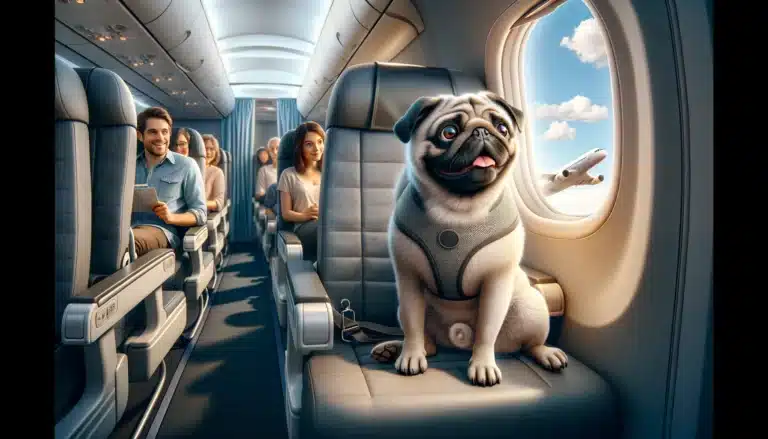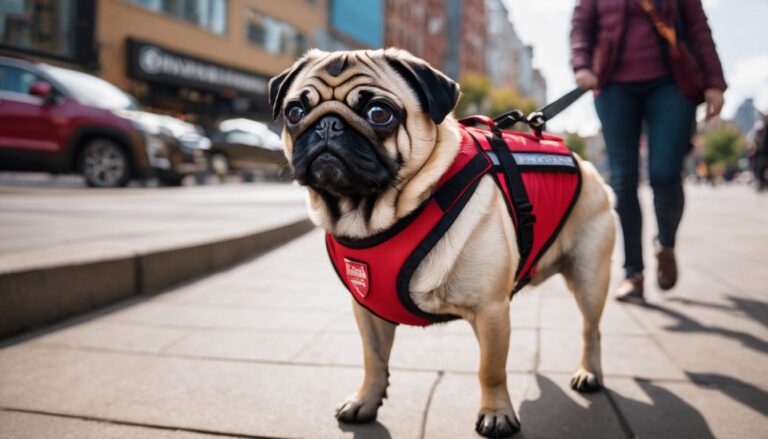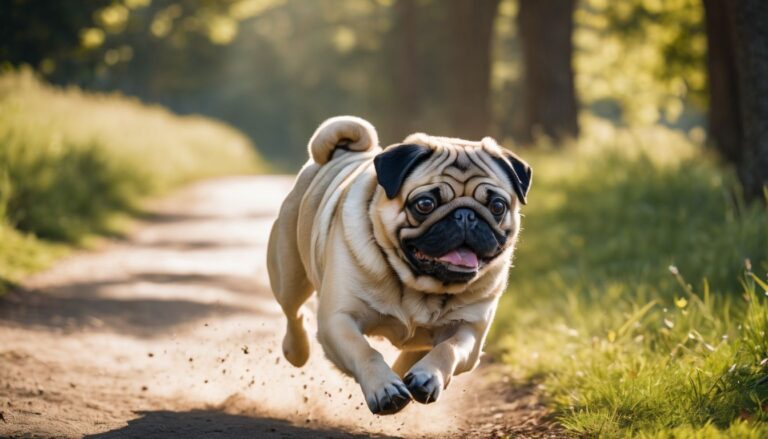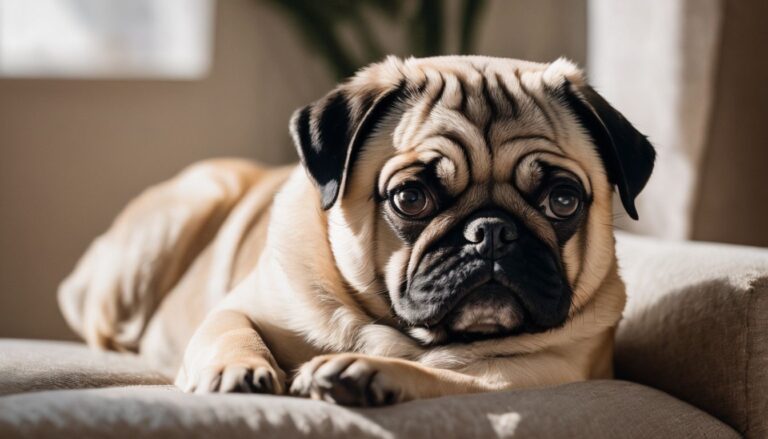The Ultimate Success Guide: How To Potty Train A Pug
How To Potty Train A Pug
Potty training a pug can feel like an uphill battle, with those big, soulful eyes looking up at you and the occasional surprise puddles in the hallway. As devoted pug lovers who’ve navigated these choppy waters ourselves, we understand that the struggle is as real as it gets.
But don’t fret! With some diligent research and tried-and-true techniques under our belts, we’ve pieced together a user-friendly guide to get through this. Our playbook is chock-full of step-by-step advice to demystify the process for you – from picking up on your little pal’s unique signals to celebrating every small victory along the way.
So let’s dig into these time-tested tactics that lead to happy dances rather than damp carpets!
Key Takeaways
- Start potty training your Pug early, around 8 weeks old, to establish good habits and stick to a consistent routine for feeding and bathroom breaks.
- Use positive reinforcement like treats and praise immediately after your Pug goes potty in the correct spot; this helps them understand what behaviors are rewarded.
- Watch for signs that indicate your Pug needs to go outside, such as sniffing or circling, and take them out routinely – first thing in the morning, after meals, following naps, and before bedtime.
- Gradually increase the areas where your Pug is allowed as they become more reliable with their potty habits; always maintain consistency to prevent setbacks.
- Consider additional tools like using potty bells for communication or enrolling in online training courses for guidance from professional dog trainers.
Understanding the Basics of Potty Training a Pug

In the journey of house training your pug, grasping the fundamentals is crucial; it’s all about setting a routine and rewarding their successes. By tapping into these core strategies, you’ll pave the way for your furry friend to master the art of going outside.
Starting early and being consistent
We know you’re excited to help your little pug puppy master the art of going potty in the correct spot. Let’s dive right in: beginning your pup’s potty training around that golden 8-week mark sets a solid foundation for good habits.
Starting early shapes their behavior before any bad habits can take root, and it’s definitely much easier than trying to teach an older dog new tricks.
Consistency is our mantra when house-training our furry friends. Stick to a regular schedule for feeding, playtime, and bathroom breaks, so your bundle of joy learns what’s expected.
Always offer treats and lavish praise immediately after they do their business outside – positive reinforcement works wonders with these adorable lapdogs. Now let’s explore how using more love than frustration can further boost their learning curve under “Using Positive Reinforcement.”.
Using positive reinforcement
Positive reinforcement sets the stage for success in potty training your pug. Every time they do their business in the correct spot, reward them immediately with treats or affection.
This doesn’t just make them happy; it helps your furry friend understand exactly what behaviors earn them praise and goodies. Treats should be small, healthy, and something they don’t get at other times so that it stands out as a special reward for using the right spot.
Praise works wonders too! Use an excited voice to let your pug know they’ve done well. It’s all about timing—be quick to celebrate their victories so they can make the connection between what they did and why it’s good.
Keep these rewards consistent and over time, you’ll notice fewer accidents around the house as your pug begins to recognize peeing in the designated area means positive outcomes for them!
Monitoring behavior
After rewarding your pug for good behavior, keep an eye out for signs that they need to go outside. Observe their actions closely. Sniffing around or circling could indicate it’s time for a potty break.
By understanding these cues, you help prevent accidents at home and reinforce housebreaking success.
We also watch our furry friends for changes in their routine or any unusual behavior that might signal discomfort or a health issue affecting their potty habits. Keeping track of when your pug eats and drinks can give you a better idea of when they’ll need to be taken out next, building up that consistent schedule crucial to effective training.
Confining to a small area
As we keep a close eye on our pug’s behavior, creating a smaller, controlled space becomes an essential step in house training. This method taps into your dog’s natural reluctance to soil their sleeping area and allows them to understand where it is appropriate to urinate or defecate.
You might start with a cozy crate or section off a puppy-proofed part of the room using baby gates. It’s important for this area to be just large enough for your pug to stand up, turn around, and lie down comfortably.
Utilizing this confined space teaches your little friend valuable habits that will stick with them as they grow older. By gradually expanding their roaming territory within the house as they show increased reliability in controlling their bladder and bowels, you’re not only nurturing good potty practices but also setting clear boundaries.
Remember to escort them directly from their special spot to their designated outdoor bathroom spot frequently – consistency here means success!
Gradually increasing freedom
We know giving our pugs more freedom around the house is a sign they’re getting the hang of potty training. But, we also realize it’s something we have to approach with care. We start by allowing access to one new area at a time when we’re confident they’ve mastered their bathroom habits in a smaller space.
This way, our furry friends don’t feel overwhelmed and can adapt without slipping up.
Let’s make each new space a fun and positive experience for them! Engage in playtime or offer treats there so they associate these places with good behavior, not just extra spots to relieve themselves.
By expanding their environment slowly, we help cement those important potty rules – consistency sets them up for success!
Exploring Advanced Techniques for Potty Training Success
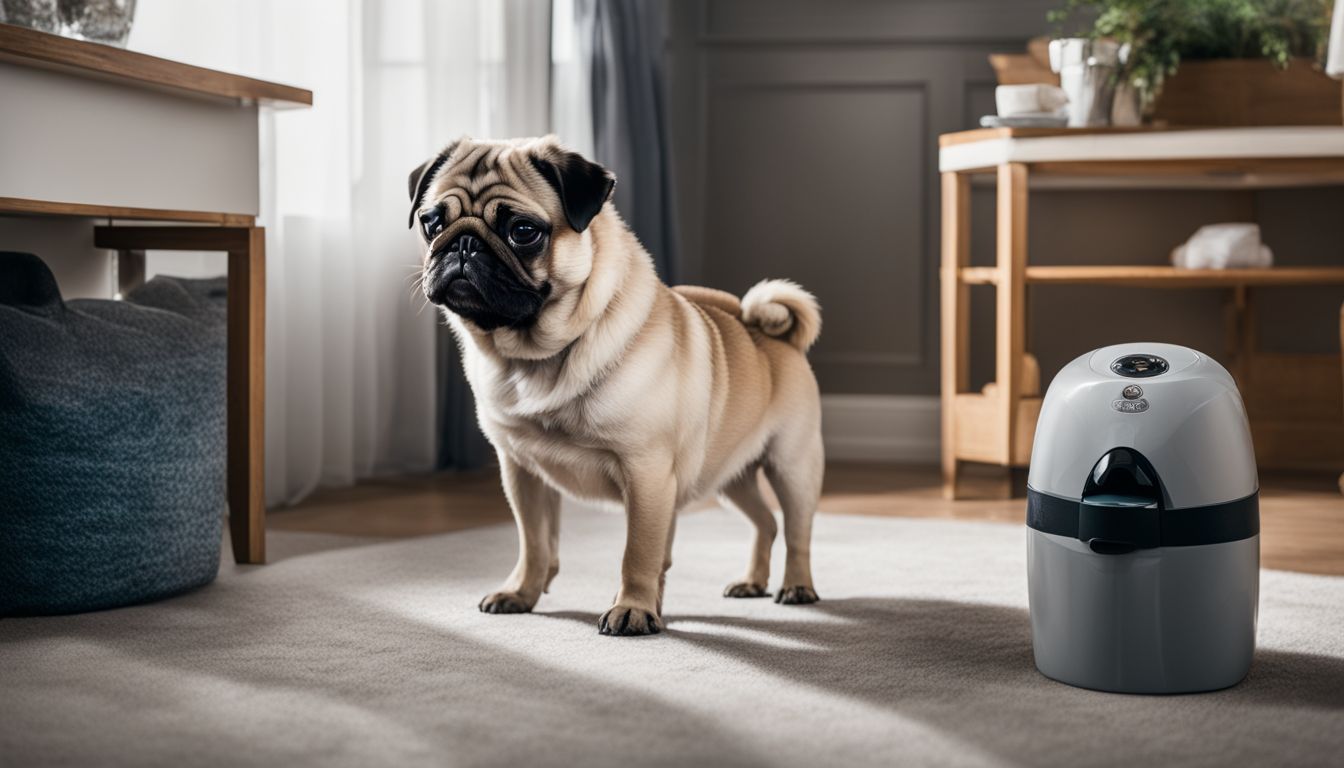
Venture beyond the basics and unlock the secrets to potty training your Pug with advanced strategies that are both innovative and effective. Discover methods that will fine-tune your approach, ensuring a smooth transition towards a fully house-trained pet.
Trying potty bells
We’ve found a fun and effective way to help house train your Pug – using potty bells! Hang a set of bells on the door that you use when taking your Pug outside for bathroom breaks.
Each time it’s potty time, encourage your furry friend to nudge the bells with their nose or paw. This will become their special signal that they need to go out.
Make sure you react quickly whenever the bell rings; this reinforces the connection between the sound and going outside to do their business. Over time, your Pug will learn this new form of communication, giving them a clear way to let you know when it’s potty time.
It’s all about positive reinforcement and patience as they master using these helpful potty bells for a happier home and a well-trained pooch.
Being patient and staying positive
Training a pug requires us to be patient and keep our spirits high, even when accidents happen. Pugs can sense our frustration, which may make them anxious and less likely to succeed at house training.
We need to celebrate every little victory with them, letting positivity guide the process. Our encouragement becomes their motivation; when they do well and are praised for it through positive reinforcement, they’re more eager to repeat those good behaviors.
Taking on the challenge of potty training with a consistent routine will lay down the foundation for success. Each day we stick to the plan is another step towards our pug mastering potty habits.
As we stay calm and collected, we create a stress-free environment that’s ideal for learning. Now let’s explore how online training courses might offer additional support in this endeavor.
Online training courses
Discovering the perfect strategy for potty training your pug might sometimes require a bit more help than anticipated. That’s where online training courses step in as an excellent resource.
These web-based programs offer comprehensive guides that cover everything from crate training to recognizing the tell-tale signs when your pug needs to go. They are fantastic for busy schedules because you can learn at your own pace, rewatch sessions, and apply new techniques immediately with your furry friend.
Online courses often feature interactive elements like videos and quizzes which keep us engaged and ensure we’re on the right track with our pug’s housebreaking progress. By enrolling in classes such as SpiritDog’s “Mastering Potty Training”, we unlock professional insights into dog behavior and effective rewards systems.
Leveraging these modern tools empowers us to tackle housetraining head-on, armed with the best strategies honed by experienced dog trainers right from the comfort of our homes.
Consulting with a veterinarian
Consulting with a veterinarian can be a game-changer in successfully potty training our pugs. Sometimes, despite our best efforts, little rascals might still have accidents inside the house.
This could signal an underlying health issue like a bladder infection or anxiety problems that we’re not equipped to handle alone. Our vets come armed with expertise and insight into dog behavior and they can offer specific advice tailored to our furry friend’s needs.
They help us understand any medical factors that may affect potty training success, such as frequent urination which isn’t just stubbornness but could be a sign of larger issues at play.
With their guidance on how to create a consistent routine and use positive reinforcement effectively, we set ourselves—and our pug—up for great results. Now let’s tackle some common questions many of us have about this whole process.
How To Potty Train A Pug Continued
Discover solutions to common puzzles pug parents face during their little one’s potty training journey, sparking more ease and success in this crucial developmental phase – dive deeper into the FAQs for expert guidance on turning accidents into achievements.
Knowing when your Pug needs to go potty
Our pugs often tell us it’s time to go outside with certain signs. They might start circling, sniffing around intensely, or heading to the door. It’s important we pay attention and act quickly! If we see any of these behaviors, let’s grab the leash and lead our little friends to their designated potty spot without delay.
To keep things predictable for them, we maintain a consistent routine. Our pugs thrive on regularity, so taking them out first thing in the morning, after meals, following naps, and before bedtime helps prevent accidents.
By recognizing their needs and sticking to a schedule, house training becomes much simpler for both us and our furry companions.
Appropriate age for potty training
We all want our pugs to master house training, and starting at the right age is crucial. The ideal time to begin this process is when they’re about 8 weeks old. At this young age, they’re more capable of learning where it’s acceptable to go potty.
Keep in mind that consistency is key; introduce your puppy to their designated bathroom spot regularly throughout the day.
Crate training helps manage your pug’s environment and sets them up for success from an early stage. It limits their space, encouraging them not to soil where they sleep. Be patient with them as puppies have limited bladder control and need frequent trips outside.
With a steady routine and plenty of praise for good behavior, you’ll find that effective potty training isn’t just possible—it can even be a bonding experience for you both!
Training an adult Pug
Training an adult Pug can feel challenging, but with the right approach, we’ll see progress. Our best strategy is to establish a routine and stick to it because consistency is our ally.
We take them out at the same times every day – after waking up, after meals, and before bedtime. Adult Pugs might already have some habits in place which we need to reshape patiently.
Crate training helps manage their space and prevents accidents when we cannot supervise them directly. We use positive reinforcement generously; treats and praise make a significant difference whenever they get it right.
And remember, patience is crucial – older dogs may require more time to break old habits and learn new ones, but they will get there with our consistent guidance and support.
Timeframe for potty training
Potty training a pug takes time and patience. Every pup is unique, but you can expect the process to take anywhere from several weeks to a few months. It’s essential to start early, ideally around 8 weeks old, as younger dogs tend to learn faster.
Remember that consistency with your efforts—sticking to regular bathroom breaks and using positive reinforcement when they get it right—is key for success.
Keep in mind that adult dogs might need extra time especially if they’ve developed bad habits or haven’t been trained before. Stick with it, reward them for their progress, and gradually extend the time between potty breaks as they become more reliable.
Next up: Let’s go over how often your Pug may need these vital potty breaks!
Frequency of potty breaks
We know you’re eager to get your pug house-trained, and keeping a close eye on the frequency of their potty breaks is crucial. Pugs, like all dogs, thrive on routine. To ensure success, take them out consistently—first thing in the morning, after every meal, following naps, and before bedtime.
Young puppies may need to go outside as often as every hour or two; however, as they grow older and gain more control over their bladder muscles, these trips can become less frequent.
It’s essential we set our furry friends up for successful potty habits from the start by recognizing when they indicate the need to go. Watch for signs such as sniffing around or looking restless—it’s time for a break! As your pug masters their training with patience and positive reinforcement from you, managing bathroom breaks will be a breeze.
Potty training in an apartment
Potty training a Pug in an apartment requires some clever strategies, but we can definitely make it work. We’ll want to designate a specific area for your pug to use as their bathroom spot – whether it’s puppy pads or an indoor grass patch.
Place these where you’d ultimately like them to ‘go,’ and be prepared with treats for instant rewards after successful use. This positive reinforcement makes them eager to repeat the behavior.
Regularly take your Pug out at scheduled times throughout the day to reinforce their potty routine, especially after meals and naps. Try using a consistent command or phrase each time so they associate those words with bathroom breaks.
Apartment dwellers typically have less outdoor space, so being on top of this schedule is most crucial—patience will be our best friend here! Remember, crate training can also help prevent accidents inside by creating a cozy den where they won’t want to relieve themselves.
Keep up the great work, and before long, your furry friend will learn where it’s appropriate to do their business – no backyard required!
Tips for Keeping Your Pug’s Ears Clean and Healthy
To keep your pug’s ears clean and healthy, make weekly checks a regular part of their grooming routine. Look out for dirt, wax buildup, or any signs of infection – these could include redness, swelling, or an unusual odor.
Use a vet-approved ear cleaner and gently wipe the visible parts of the inner ears with a soft cloth or a cotton ball; never insert anything deep into the ear canal. If there’s excessive head shaking or scratching at their ears, it might be time to consult your veterinarian for advice.
Turning your attention to their diet can also play a role in ear health since food allergies often manifest with ear issues in dogs. We’ll ensure they get all the right nutrients without those troublesome ingredients that could cause harm or discomfort.
It’s essential to avoid foods that may trigger sensitivities as we move on to discussing which foods are not beneficial during the potty training process.
Foods to Avoid While Potty Training a Pug
Keeping your Pug’s ears clean is just one step towards their overall well-being, but the foods they eat play a crucial role too, especially during potty training. We know how important it is to maintain a proper diet for our furry friends to support their house training efforts.
- Avoid giving your Pug table scraps: These can disrupt their digestive system and make potty training more challenging. Stick to high-quality dog food that meets the American Kennel Club’s nutritional standards.
- Steer clear of dairy products: Milk and cheese might cause stomach upset in Pugs, which can lead to accidents indoors. We want their little tummies feeling good so they can focus on learning where to go potty.
- Keep spicy foods out of reach: Spices are known for upsetting a dog’s stomach and bowels. Since consistent routine is essential in potty training, we don’t need any unexpected messes!
- Say no to foods high in fat: Fatty foods can trigger pancreatitis in dogs, an inflammation that’s not only painful but also hampers the regularity needed for effective house training.
- Skip the sweets and chocolate: Besides being toxic, sugary treats can cause rapid changes in your Pug’s energy levels and bathroom habits. Consistent energy means consistent potty patterns.
- Limit treats while training: While positive reinforcement is key, too many treats may lead to frequent urination or bowel movements that conflict with the potty schedule we’re trying to establish.
Additional Resources for Potty Training a Pug
For those committed to mastering the potty training journey with their lovable Pugs, a wealth of additional resources awaits—each one designed to guide you through this essential aspect of pet parenthood.
Pug Village
We know how much you adore your pug, and we’re here to help make potty training a breeze. Pug Village is an online haven for pug parents seeking support and tips on everything from house training to health advice.
It’s a treasure trove of articles, interactive forums, and helpful resources where experienced owners share their successes and challenges with potty training these unique little pups.
By tapping into this community, you’ll find the encouragement needed to stay consistent with your training efforts.
At Pug Village, the collective wisdom underscores that patience is just as important as using positive reinforcement strategies. Engaging with this vibrant community helps us understand our pugs’ behavior better which ensures effective housebreaking routines that stick.
Armed with these insights from fellow pug lovers, move onto learning about maintaining those adorable ears in “Tips for Keeping Your Pug’s Ears Clean and Healthy.”.
PetVet.AI online advice
Shifting gears from community forums like Pug Village, PetVet.AI steps in to provide a technological edge to your pug’s house training journey. Imagine getting personalized advice for your pug’s unique behavior and needs, all at the click of a button.
PetVet.AI harnesses the power of artificial intelligence to offer targeted solutions for common issues such as recall troubles or stubborn barking habits that may interfere with effective potty training.
As you work through the crate training process or establish a consistent routine, this innovative tool can become an invaluable part of your arsenal. The platform analyzes patterns in your pug’s behavior, giving insights into their specific housetraining challenges.
This means if you’re dealing with scent marking or trying to get your furry friend to pee on command in the litter box, PetVet.AI could guide you towards overcoming these hurdles with data-driven suggestions tailored just for you and your beloved pug.
Pug Village newsletter
We know how much you love staying up-to-date on all things pug, and the Pug Village newsletter is your go-to source for tips, stories, and advice. Delivered straight to your inbox, each issue is packed with useful information tailored specifically for your pug’s needs.
From mastering house training techniques to understanding their unique behavior patterns, our newsletter has it covered.
Subscribe today and join a community passionate about these charming companions. We share insights on effectively housetraining your furry friend using positive reinforcement and consistency – essential keys to success mentioned in our important facts.
With every read, you’ll feel empowered to tackle the joys of potty training while keeping your beloved pet happy and healthy.
Laura Meskanen-Kundu’s articles
Laura Meskanen-Kundu’s articles serve as a treasure trove for pug owners looking to navigate the challenges of potty training their furry friends. She dives deep into innovative techniques that complement our efforts in creating a consistent routine and offering positive reinforcement, which are crucial elements for success.
Her insights help us understand our pugs’ behavior better, guaranteeing we’re well-equipped to handle the task with patience and knowledge.
Drawing from her extensive experience, Laura provides practical advice on effectively using crate training and managing your dog’s environment—strategies that set you up for triumph in housebreaking your pug.
With clear guidelines and actionable tips, she ensures readers can apply these lessons immediately, making the journey of raising a happy, obedient pug smoother.
How To Potty Train A Pug Conclusion
We’ve shared a treasure trove of tips and tricks to help you navigate the potty training journey with your beloved pug. Remember, understanding your furry friend’s habits and needs is the foundation for successful house-training.
Embrace patience, sprinkle in lots of positive reinforcement, and watch as your pug masters this important life skill. Keep these guidelines handy; they’re your roadmap to a happy, well-trained companion! Let’s celebrate each small victory on the path to a perfectly potty-trained pug.
How To Potty Train A Pug FAQs
1. What are the first steps to house train my pug?
Begin by creating a consistent routine for your pug and take them outside frequently, especially after meals or naps. Use clear commands and positive reinforcement to guide obedience during training.
2. Can I use collars to help with pug dog training?
Collars can be used as part of dog training, but they should be comfortable for your pug and used responsibly alongside other training methods focused on positive reinforcement, not punishment.
3. How do I handle separation anxiety in my pug during potty training?
To minimize separation anxiety, start with short absences and gradually increase the time you’re away. Provide toys or treats to keep your pug busy, ensuring they feel safe even when you’re not around.


